This is a feature that allows you to send vulnerabilities from Faraday to JIRA. Through this process you will see how to
JIRA's Configuration¶
Follow the instructions based on you JIRA Instance (On-prem or Cloud)¶
JIRA On Prem Software Configuration¶
Copy your instance URL and Project Key from your JIRA instance information:

JIRA Cloud¶
Copy your JIRA Instance URL and Project Key information:

URL (example): https://example.atlassian.net/
Project Key (example): FARADAYKEY
we need to activate OAuth Authentication:
Inside your JIRA Cloud click on the gear icon at the top-right corner (left side of your profile icon) and click on
Products, then, on the left-side bar, click on Application links


On the input bar at JIRA, enter your Faraday's URL (example: http://localhost:5985)
If this message appears and the URL is correct, just click Continue
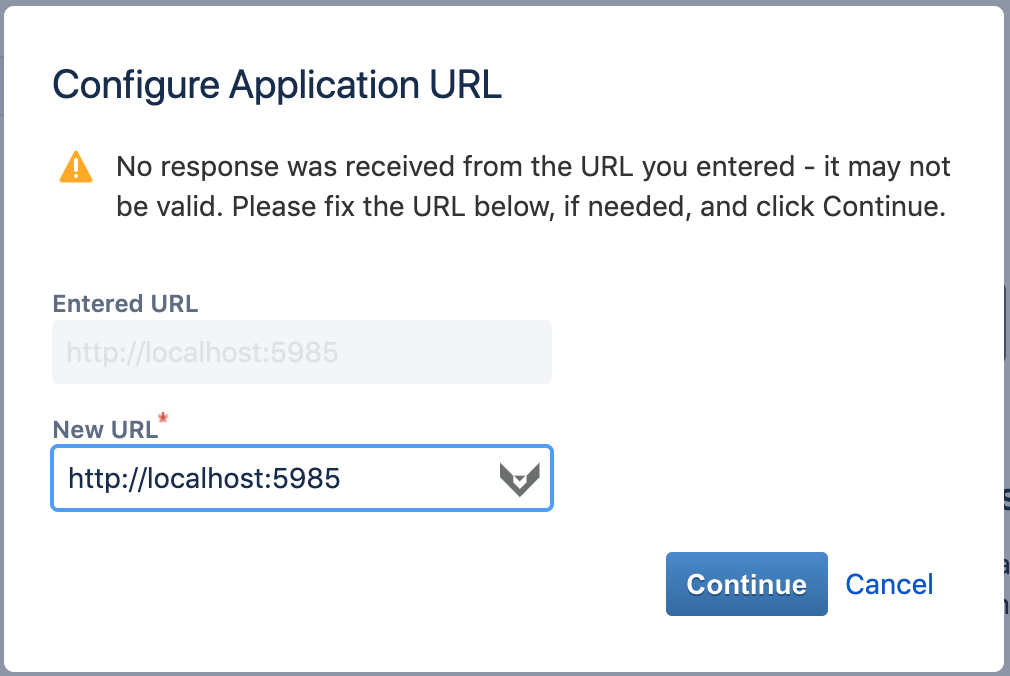
Fill the application fields, in this case, Faraday as the Application Name, you must select the option
Generic Application as the Application Typeand Mark the option Create incoming link. Then, click Continue.

Now, you will need to generate in Faraday a:
Consumer Key: you should copy and save this for after configuration at Faraday.
-
Consumer Name: In this case, we use Faraday.
-
Public Key: Following the Jira configure flow, at the end there is a generate key button.
Just copy and paste it inside your Public Key field at JIRA.-----BEGIN PUBLIC KEY----- 9YxXl4D/aL/iE94MsUc9t3FFoNCP97Sfel7o+1q5YOF79qlKGbP3mXgbel/LUaSj Vd91dnpg1OS1PH0p6YMDsCQfXSVBpC2OUY2hDkEwPUT/OKeAq+XE5sqEqoUeDdrS OOWVuEYlWZl6ghS2TABFN5VXPgWg30Ne4L0nlDqJh2BD7RACa+Wpzbr2b/HmIxSf WOj6mu7eK7Vx38CyrnOci8u59Mv/IXsEppU6nGgMZ7/Hw1ojaeSn0W6wF0Wsk3EG RY/wYngdCYQEQx0rDnannBnP6EuYaqwBtNjcPpp9zvsZt+d1qmOWbii4rbqfY4BR n42R05zamkSNqbwdoQ1JDyv90D6lrG+JLq/BjHaIJlAhnDIWfX6DtqgUOD3VUQfC GQvvguRA -----END PUBLIC KEY-----
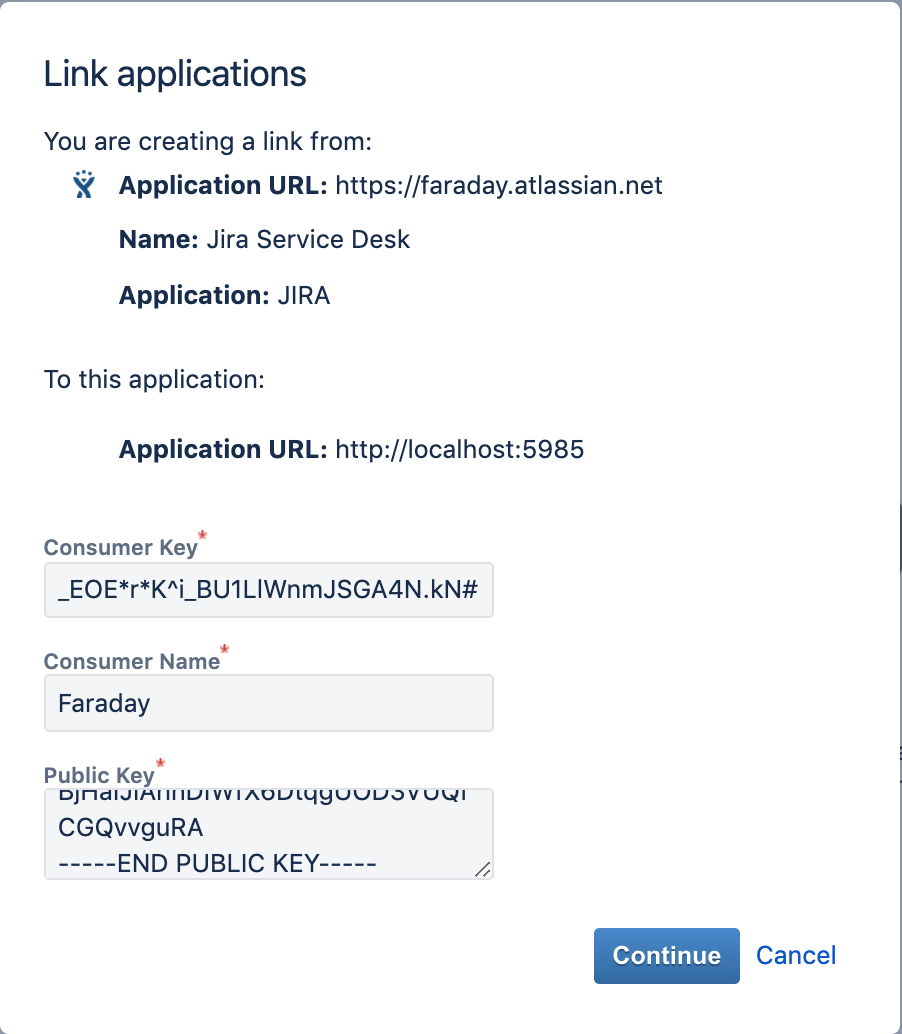
Then, click Continue to generate the application.
If everything is Ok, you should see this screen:

Faraday authenticates to Jira using OAuth 1.0
Begin authentication¶
Once you’ve created the Application Link, go to Faraday’s Settings and select the Ticketing Tools section.
Once there, select JIRA and you will see a slide button near to OAuth Authentication click it.
Wait a few seconds (it may take a while if you have many projects and users in jira)
Authorize the Oauth and hit ok in the button of Jira OAuth.
Faraday's Configuration¶
Login into Faraday's Web UI and go to Setting clicking on your username in the top right corner:

Inside Settings, navigate to Ticketing Tools and Select JIRA from the dropdown menu:
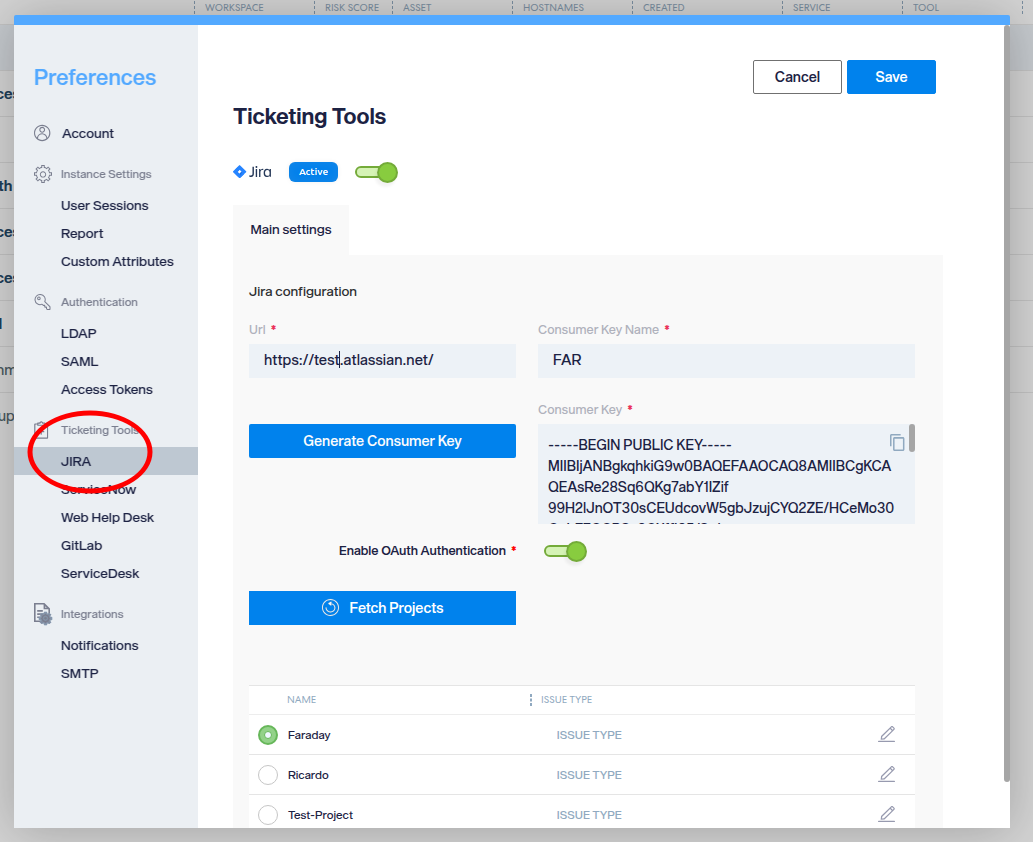
JIRA Configuration¶
Inside the ticketing tool at Faraday, paste your instance URL and Project Key, then, add your Consumer Key
into the OAuth Authentication field, after this, click the round button to authenticate!
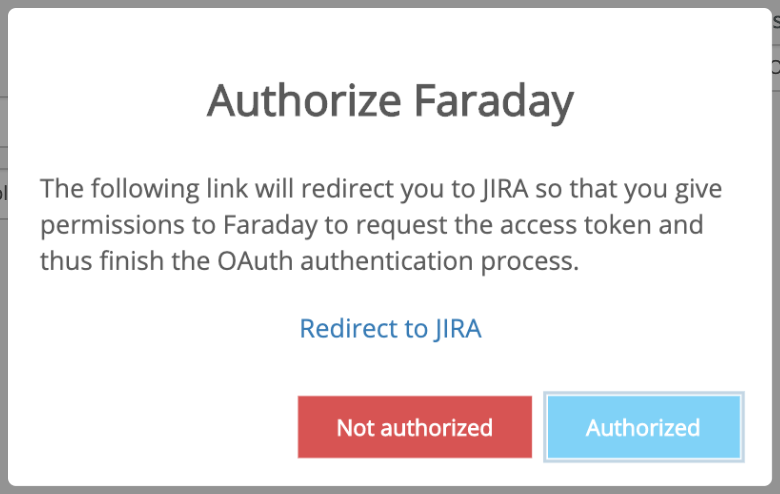
You should see this, click on Redirect to JIRA, once on JIRA website, click on Allow and wait until receive an Access Approved message, once received, close the tab.
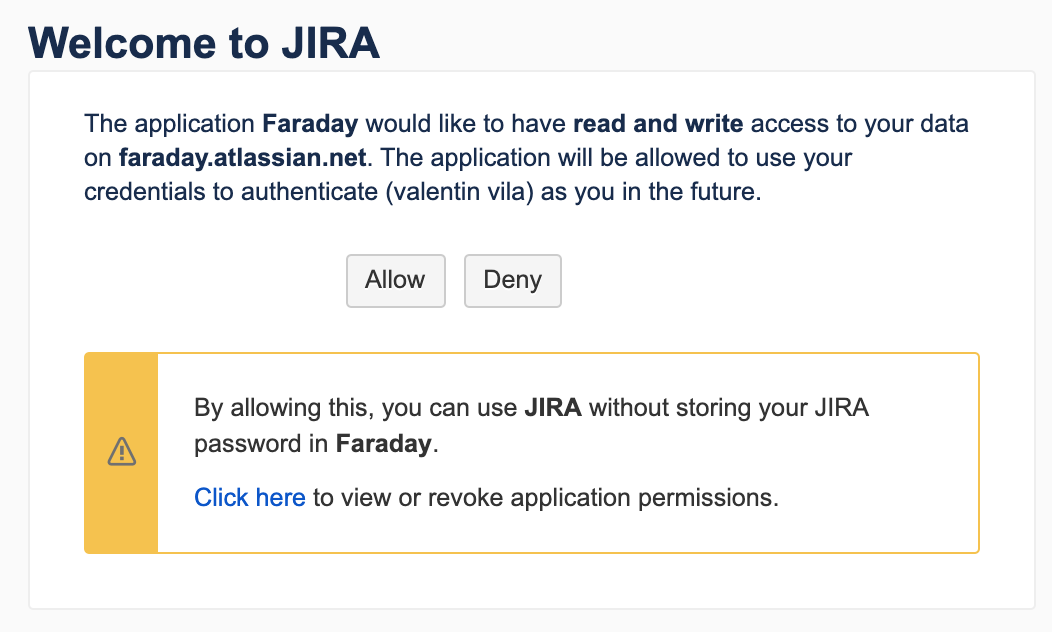

Once in Faraday, click on Ok.
Configure Jira users in Faraday¶
Inside Preferences, navigate to Ticketing Tools: - Select Jira - Click on Fetch Projects - Click on Edit Project
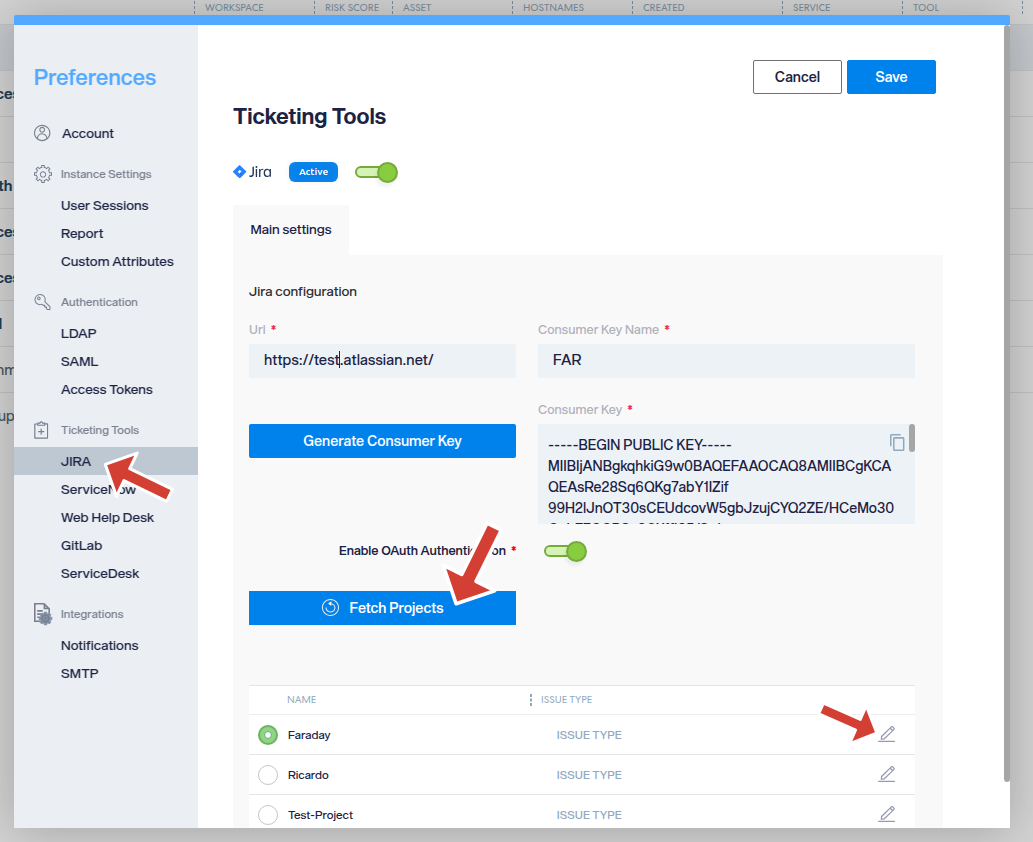
Add user in Project Modal:
- Add user with search box (Use Display Name or User Email)
- If the user is added correctly, then the user will be allowed to be reporter in the "reporters" field.
- Select Reporter en Reporter Box
- Click on Save Button

User added correctly!
Configure Default Project in Faraday¶
Now all that remains is to configure the default project to submit vulnerabilities.
- Click on Fetch Projects button
- Select default project in list *(Only in pre-configured project)
-
To finish click on Save Button on top
-
You can configure project with edit button on the right side of the table
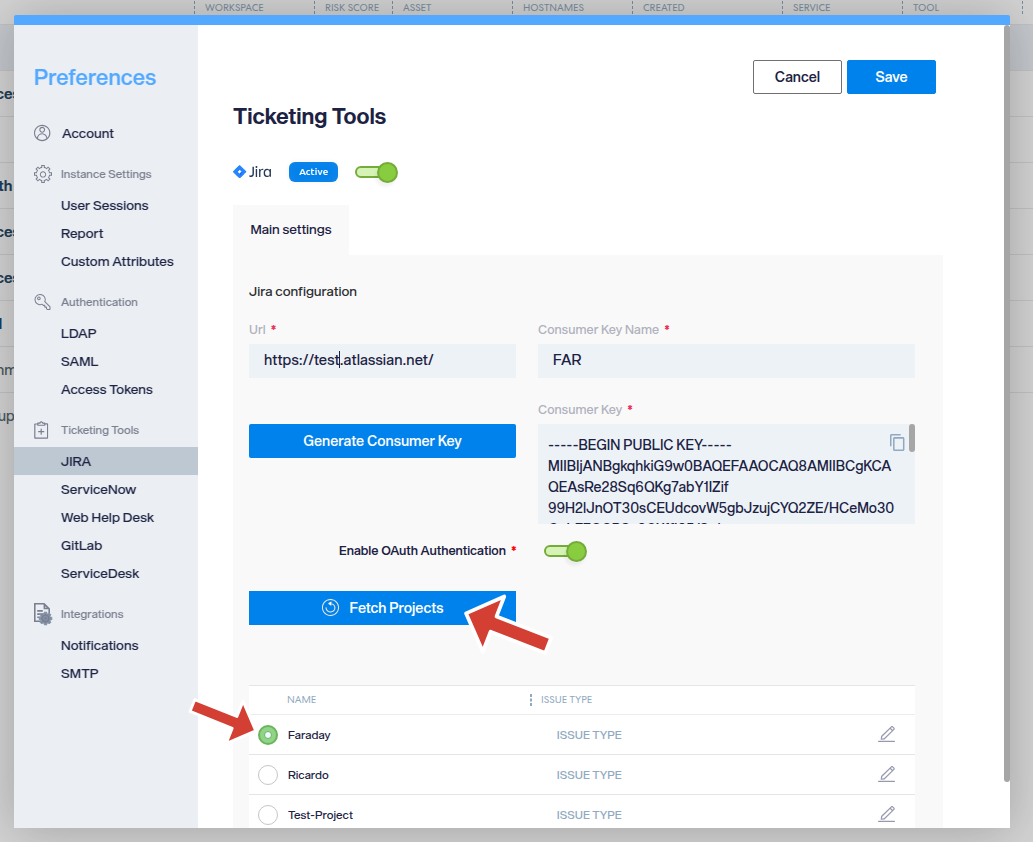
Send vulnerability to JIRA¶
Navigate to the Manage > Vulns view inside Faraday's Web UI
To send vulnerabilities to JIRA, select the desired vulnerabilities, click on the Tools button at the top-right corner and then click on JIRA.
![]()
Click on the dropdown menu Add columns and add the issuetracker column.

![]()
Now, select the vulnerability you want to export and click on Tools > JIRA
Keep in mind that only confirmed vulnerabilities can be sent.
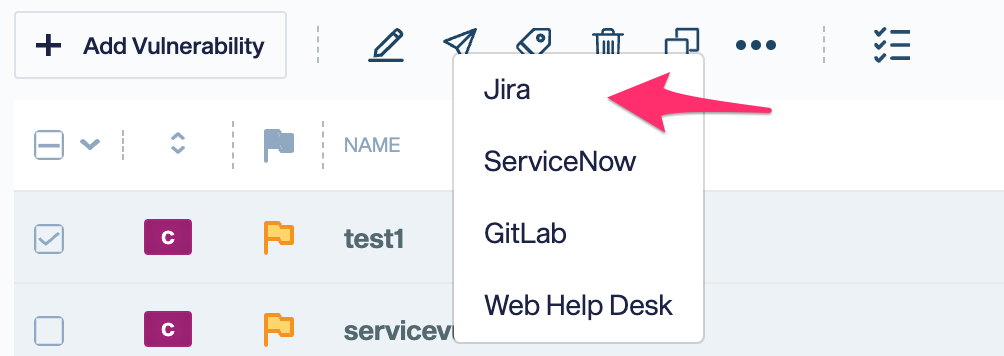
Once the JIRA dialog opens, you have two options:
You can use the default data saved in the Ticketing Tools section of Settings (see Save JIRA's Configuration for more information):
You can overwrite JIRA default data by clicking on the checkbox button and then manually input your JIRA credentials. Then click OK:
If you overwrite only one field, Faraday will fill the others fields with the default data. E.g: if you overwrite Project Key, Faraday
will fill URL field with the information you have saved in Settings.
You should see the word JIRA appearing on the issuetracker column at your vuln, you can click on it to
see the issue that has been created on JIRA!

In Jira

Template The template is preloaded in description but you can use the fields described in our jinja2 context
doc Link
The template's name where you'll define the issue's description. You can call any attribute of the vulnerability object
using Jinja2 syntax. E.g., if you want your issue in JIRA to have as description the target, the hostnames,
and the severity of the vulnerability, the template would be as follows:
{# This is a Template for Faraday Jira Integration #}
{# Pre-Flight Adjustments #}
{% set issuetracker_config = 'jira' %}
{% set http_size_config = 4096 %}
{% if 'med' in vuln.severity %}
{% set corrected_severity = 'Medium' %}
{% else %}
{% set corrected_severity = vuln.severity %}
{% endif %}
{# Issue template structure should go under this comment #}
{% if 'VulnerabilityWeb' in vuln.type %}
# [{{ corrected_severity | capitalize}}] {{vuln.name}} - ({{vuln.path}})
{% else %}
# [{{ corrected_severity | capitalize}}] {{vuln.name}}
{% endif %}
## Description
{{ vuln.desc }}
#### This issue has been rated as: `{{ corrected_severity | capitalize }}`
Affected Asset: {{vuln.target}}
{% if vuln.website %}
Affected URL: {{ vuln.website }}{{ vuln.path }}
{% endif %}
{% if vuln.hostnames %}
#### Hostnames
{% for hostname in vuln.hostnames %}
- {{hostname}}
{% endfor %}
{% endif %}
## Recommendations
{{ vuln.resolution }}
{%for ref in vuln.refs%}
- {{ref}}
{%endfor%}
{%if vuln.easeofresolution%}
#### Estimated ease of resolution
{{ vuln.easeofresolution | capitalize }}
{%endif%}
### Technical Details
{%if vuln.data%}
#### Proof of Concept
{{vuln.data}}
{%endif%}
{%if vuln.request%}
#### Request
{{vuln.request|truncate(http_size_config, False, '...', 0) }}
{%endif%}
{% if vuln.response %}
#### Response
{{ vuln.response|truncate(http_size_config, False, '...', 0) }}
{%endif%}
## Issue [{{ vuln.id }}] {{vuln.name}} [{{vuln.status}}]
{# A vulnerability might be associated with more tha one issuetracker id #}
{% for key, value in vuln.issuetracker_json.items() %}
{% if issuetracker_config in key%}
This issue has already been reported in this platform:
- {{ key | capitalize}}
{% for line in value %}
- Issue: {{line.url}}
{% endfor %}
{% endif %}
source: created by {{vuln.owner or "faraday"}} using {{vuln.tool}} - {{vuln.external_id}} - {{vuln.date}}
{% endfor %}
{# end of file #}
You can also link an issue to an Epic. To do so, look after the custom field Epic Link of your instance and add
it to your issue’s configuration (just as the example above). Once you add it, you need to type in the input field the issue keys of the epic.